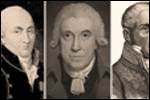
|
|
BOOKS AND ARTICLES
Heinrich Rudolf Hertz (1857-1894). Biography of a scientist Directory / The life of remarkable physicists
A cheerful flock of schoolchildren runs along the street. A snippet of conversation is heard: "Cool station at a frequency of 101,4 megahertz!". Do these boys know whose name they just said? Everywhere: in mechanics, electrical and radio engineering, nuclear physics and other sciences, one hertz means one oscillation per second. The great German physicist Heinrich Rudolf Hertz was born on February 22, 1857 in Hamburg. Already in childhood, he was distinguished by amazing abilities and memory. After graduating from school in 1875, Hertz at first could not choose the right profession and began to study architecture, but soon became disillusioned. He began to study at the Polytechnic School in Dresden, did not like it, transferred to the Polytechnic School in Munich, studied for one year. Transferred to the University of Berlin. Here, finally, Hertz met real teachers: Hermann Helmholtz (an outstanding acoustician) and Robert Kirchhoff (everyone knows his laws of electrical engineering). In 1880, Hertz brilliantly graduated, moreover, he received a gold medal from Humboldt University for solving one of the competition problems. Naturally, the talented graduate was left at the University of Berlin as a teacher of physics. In 1883, Hertz was invited to the post of professor at the University of Kiel. Becoming a professor at 26 was a kind of record (Ampère and Ohm became professors at 28, and Volta at 29). In 1885, Hertz moved to the position of professor of experimental physics at the Karlsruhe Technical School, where his scientific discoveries took place. In 1865, the English scientist James Clerk Maxwell published a system of equations that related electric and magnetic fields. From the equations it followed that supporting each other, these fields can propagate in space, forming a single electromagnetic field. Maxwell's equations were written at such a high mathematical level (they are now studied in the senior courses of radio engineering universities) that few in Europe understood their meaning. Heinrich Hertz understood this and immediately introduced Maxwell's equations into the course of his lectures. The great Russian scientist D.I. Mendeleev once threw the phrase: "You can say it all, but you go and demonstrate!" Theories are not believed in science, they must be proved experimentally. Heinrich Hertz understood this very well and set out to prove the validity of Maxwell's equations. In 1887, he created a circuit containing an inductor and a capacitor. Moreover, the capacitor consisted of two plates with a gap between them. When energy was introduced into the circuit, the capacitor turned into a spark gap, a spark jumped between the plates, due to which an electromagnetic wave was radiated into space with a frequency equal to the resonant frequency of the transmitting circuit. The receiving circuit was tuned to exactly the same frequency, oscillations were induced in it, and sparks also jumped in its capacitor-discharger. Now Hertz could calmly talk at lectures about the existence of electromagnetic waves. One day one of the students asked the professor: "What is the practical significance of your experiment?". The young professor shrugged his shoulders and said, "None." In the process of working on his resonator, Hertz discovered that if the gap of the capacitor was illuminated with ultraviolet rays, the sparks became more intense. Thus, the phenomenon of the external photoelectric effect was discovered. In 1889, Hertz went to work at the University of Bonn, where he continued to work on the problems of mechanics (his capital work "Mechanics" was published after his death). The scientist died prematurely. While conducting experiments in the laboratory, Hertz injured himself, blood poisoning began, and on January 1, 1894, Heinrich Hertz died before he was 37 years old. Just over a year, Heinrich Hertz did not live to see the invention of the radio. On May 7, 1895, Alexander Stepanovich Popov demonstrated the transmission of a message by radio. Probably the best monument to the great German scientist was the text of the world's first radiogram: "Heinrich Hertz". << Back (Nikola Tesla)
 Read and write useful comments on this article. Read and write useful comments on this article.
Machine for thinning flowers in gardens
02.05.2024 Advanced Infrared Microscope
02.05.2024 Air trap for insects
01.05.2024
▪ Four-door refrigerator Haier Haier 518L ▪ BLU Dash 4.5 Quad Core Dual SIM Smartphone ▪ Spray instead of solar panels ▪ Nanocrystals protecting fruit trees from frost ▪ Magnetic monopoles in a cold quantum gas medium
▪ section of the site Audio and video surveillance. Selection of articles ▪ article Erinburg Ilya Grigorievich. Famous aphorisms ▪ article Can it be artificially made to rain? Detailed answer ▪ article photojournalist. Job description ▪ article T-contour. Encyclopedia of radio electronics and electrical engineering
Home page | Library | Articles | Website map | Site Reviews www.diagram.com.ua |






 Arabic
Arabic Bengali
Bengali Chinese
Chinese English
English French
French German
German Hebrew
Hebrew Hindi
Hindi Italian
Italian Japanese
Japanese Korean
Korean Malay
Malay Polish
Polish Portuguese
Portuguese Spanish
Spanish Turkish
Turkish Ukrainian
Ukrainian Vietnamese
Vietnamese

 See other articles Section
See other articles Section 